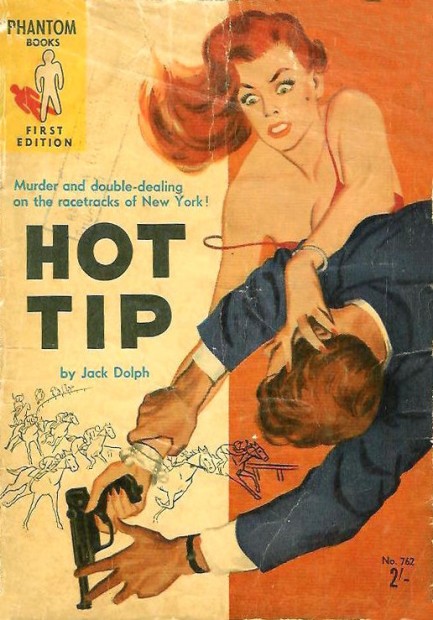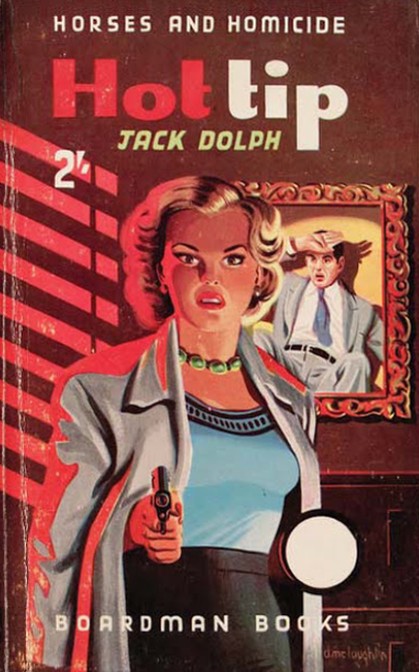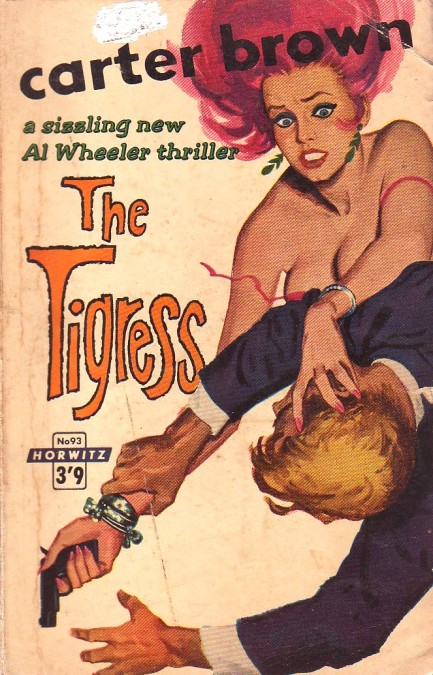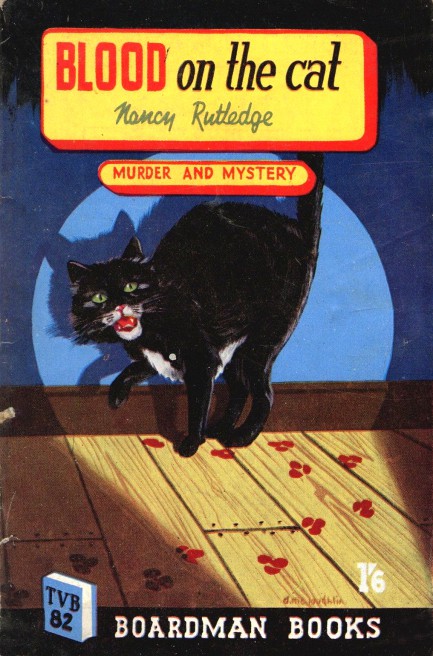 Looks like she's well past the tipping point. 
Any successful concept has the potential to become a cage for a crime author. Jack Dolph wrote the successful 1948 mystery Odds-On Murder about race tracks and their associated environs, and returned to that milieu for 1950's Murder Makes the Mare Go. In 1952's Hot Tip, for which you see the 1957 Phantom Books cover art above, Dolph is still hanging around the track, where a jockey dies in a sweatbox trying to make weight for a race, and his buddy Doc Connor sets about proving it was murder. There are suspects—the wife who stood to inherit insurance bucks, the estranged brother, and shady  gamblers, while artsy Broadway types provide extra color. gamblers, while artsy Broadway types provide extra color.
Dolph used Doc Connor for all his horse books, with the character's interest in racing legitimizing his constant moonlighting as a sleuth when he probably should have been inoculating babies and reading x-rays. We described these concepts as a cage for authors, but that's our personal bias intruding. Dolph might have loved writing about racing. But either he or the public tired after his fourth foray and fifth novel overall, 1953's Dead Angel, at which point Dolph went out to pasture.
The art on the 1957 edition from Australia's Phantom Books is interesting but uncredited. The British edition from Boardman Books, just above, has nice cover art as well, painted by Denis McLoughlin. And the original art was reconstituted by Horwitz Publications, also Australia based, for usage on the front of Carter Brown's The Tigress, from 1961, below. Though actually, based on the quality of the art, Phantom's Hot Tip art looks like the copy, but the publication dates we have say Phantom was first. 
 Okay, okay, I get it—you refuse to eat the dry food. 
llustrator Denis McLoughlin had a seven-decade career during which he produced close to 800 paperback covers and dust jackets. His front for Nancy Rutledge’s, aka Leigh Bryson’s, Blood on the Cat is one of more unusual efforts you’ll see. It depicts the moment a small town newspaper editor finds that his cat Smoky has tracked blood into the house. A search outside turns up not the expected disemboweled unfortunate from lower on the feline food chain, but a beautiful woman passed out in a blood-splattered car. The mystery races onward from there, with suspects that include the town librarian, the bookish schoolmarm, a rich man’s disinherited son, and numerous other smallville types. Blood on the Cat was published initially in 1946, with this Boardman paperback appearing in the UK in 1950.
|
 |

The headlines that mattered yesteryear.
1933—The Gestapo Is Formed
The Geheime Staatspolizei, aka Gestapo, the official secret police force of Nazi Germany, is established. It begins under the administration of SS leader Heinrich Himmler in his position as Chief of German Police, but by 1939 is administered by the Reichssicherheitshauptamt, or Reich Main Security Office, and is a feared entity in every corner of Germany and beyond. 1937—Guernica Is Bombed
In Spain during the Spanish Civil War, the Basque town of Guernica is bombed by the German Luftwaffe, resulting in widespread destruction and casualties. The Basque government reports 1,654 people killed, while later research suggests far fewer deaths, but regardless, Guernica is viewed as an example of terror bombing and other countries learn that Nazi Germany is committed to that tactic. The bombing also becomes inspiration for Pablo Picasso, resulting in a protest painting that is not only his most famous work, but one the most important pieces of art ever produced. 1939—Batman Debuts
In Detective Comics #27, DC Comics publishes its second major superhero, Batman, who becomes one of the most popular comic book characters of all time, and then a popular camp television series starring Adam West, and lastly a multi-million dollar movie franchise starring Michael Keaton, then George Clooney, and finally Christian Bale. 1953—Crick and Watson Publish DNA Results
British scientists James D Watson and Francis Crick publish an article detailing their discovery of the existence and structure of deoxyribonucleic acid, or DNA, in Nature magazine. Their findings answer one of the oldest and most fundamental questions of biology, that of how living things reproduce themselves. 1967—First Space Program Casualty Occurs
Soviet cosmonaut Vladimir Komarov dies in Soyuz 1 when, during re-entry into Earth's atmosphere after more than ten successful orbits, the capsule's main parachute fails to deploy properly, and the backup chute becomes entangled in the first. The capsule's descent is slowed, but it still hits the ground at about 90 mph, at which point it bursts into flames. Komarov is the first human to die during a space mission.
|

|
|

It's easy. We have an uploader that makes it a snap. Use it to submit your art, text, header, and subhead. Your post can be funny, serious, or anything in between, as long as it's vintage pulp. You'll get a byline and experience the fleeting pride of free authorship. We'll edit your post for typos, but the rest is up to you. Click here to give us your best shot.

|
|


 gamblers, while artsy Broadway types provide extra color.
gamblers, while artsy Broadway types provide extra color.






































































